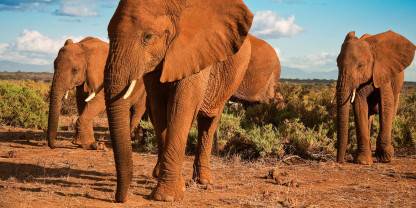Average Expert Rating
Rating Breakdown
Write a User ReviewSamburu’s Off-the-Beaten-Track Neighbor
Shaba National Reserve, nestled alongside the more renowned Samburu and Buffalo Springs National Reserves, offers an off-the-beaten-track safari experience. While wildlife sightings might be less frequent compared to its neighboring reserves, the exclusivity of Shaba makes it worth a visit.
The reserve doesn’t boast easy sightings of the Big Five, but it is home to a fascinating array of rare and localized dry-country specials that are the true highlights of this area. Among the reserve’s distinctive inhabitants are dik-dik, a cute antelope with a charming demeanor, and gerenuk, known for its strikingly elongated neck. The oversized Grevy’s zebra and the stunning reticulated giraffe, with its unique web-like patterns, are also easily seen. One of Shaba’s most distinctive features is its flat-topped acacia trees, which dot the landscape like natural umbrellas. These iconic trees create pockets of shade in the harsh midday sun, offering a vital refuge for the wildlife.
Part of the Dry-Country Safari Ecosystem in Northern Kenya
On the fringes of Kenya’s desert region, Shaba shares the Ewaso Ng’iro River system with neighbouring Samburu and Buffalo Springs national reserves on the other side of the Isiolo–Archers Post road (A2). I spotted elephant, jackal, bat-eared fox and plains game, including the beautifully marked Grevy’s zebra and the handsome reticulated giraffe, but my experience was that you have to work harder to find the animals. Unlike Samburu and Buffalo Springs where almost all game drives are concentrated along the flat riverbanks, Shaba’s wildlife is also drawn to the marshy areas and scattered natural springs. Some of the tough four-wheel-drive tracks to get around the reserve negotiate steep hills, rocky kopjes, thorny scrub and gritty volcanic surfaces and can be bumpy and uncomfortable. The advantage is Shaba is more scenic and solitary than the other two, but in terms of animals, I found it not quite the equal of its neighbours for population density and ease of locating them. As such, it’s a good idea to combine all three national reserves on a combined safari.
Samburu’s Wilder Eastern Cousin
Set in the same part of Kenya as Samburu National Reserve, from which it is separated by the main road running north to Ethiopia, Shaba is a little-known reserve that enjoyed a brief flirtation with fame when ‘Survivor Africa’ was filmed there back in 2001. Fittingly, this tract of open acacia scrub has a wilder and more untrammeled feel than Samburu itself, with very little tourist traffic exploring the dusty roads that run east from its only large lodge, offering a genuine wilderness experience to those who visit. However, while it protects a similar range of species to Samburu, including gerenuk, Grevy’s zebra and lesser kudu, wildlife is thinner on the ground, and relatively skittish, so best to come here for the overall bush experience rather than for pure game viewing.
The Quiet Wilderness
Shaba gets very few visitors, and that’s why I love it. Yes, it doesn’t have as much wildlife as nearby Samburu or Buffalo Springs, and tourism infrastructure is limited. But there is a palpable sense of being in a Kenya that very few visitors see, of exploring wild northern Kenya much as the explorers did a century ago.
When it comes to wildlife, anything you see here is a bonus. I always find that with that comes an opportunity to change the way I explore, to be fully present in the moment and appreciate the smaller details that sometimes get overlooked in the rush to see the Big Five or watch a predator on the hunt. Shaba is rough and ruggedly beautiful. I wouldn’t go there on my first safari, but I’d definitely visit as part of a trip to deepen my knowledge of this remarkable country.
One of Northern Kenya’s Desert Gems
There’s a good reason why Joy Adamson set up her leopard research operations in Shaba National Reserve and these days many people return to relive those famous experiences (albeit on a markedly more grandiose scale these days) at the luxurious Joy’s Camp. Big cat sightings are far from guaranteed but even if you just sit still at the waterhole where Joy camped (and was murdered), the procession of wildlife that passes through is truly astounding. Without even moving from your chair in front of your perfectly appointed Hemingway-style tented suite you are likely to have good sightings of elephant, oryx, zebra, giraffe and impala. When water gets extremely scarce in nearby Samburu National Reserve then Shaba, with its springs, can often be the best bet. It can get hot and dusty in this area too, but this park, with its sandy gullies, rocky lava plains and spectacular kopjes gives the feeling of remote, backcountry Africa and you will rarely see other visitors.
The Wild North
What I like about this park is how
Read more
quiet it is. There are only two camps here (including Joy’s camp, one of the most ornate tented camps in Kenya) and I have spent full days here without seeing a single other tourist safari vehicle. This gives Shaba a wonderfully wild feel. One of my abiding memories of a safari here was climbing to the top of one of the granite outcrops known as a kopje for a sundowner drink. After 20 minutes we looked down towards the parked jeep to see three lionesses prowling around between us and the jeeps. I did what any sensible grown-up would do in such circumstances and quickly knocked back a couple more G&Ts (for gin-infused courage and to numb the pain if we didn’t get back to the jeeps!).Joy and Solitude
Wildlife viewing at Shaba is generally less productive than in the better-known Samburu, at least in terms of quantity. Though

